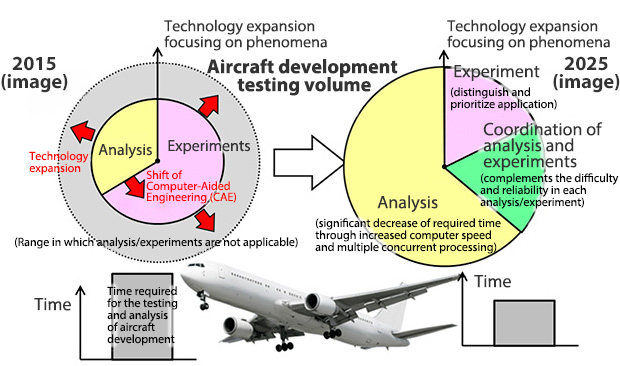Research & Development
JAXA promotes three research and development programs and a fundamental research program that underpins them.
Applied fundamental technology
Japan already possesses an extremely high level of fundamental technology in the aeronautical field. However, no system exists for the swift application of this technology to aircraft development.
JAXA is developing applied fundamental technology to enable the application of our accumulated fundamental technology to the design, development, evaluation and certification of aircraft systems, and to revolutionize associated processes. By doing so, we aim to help enhance the international competitiveness of the Japanese aircraft industry.

Supporting aircraft development through advanced fundamental technology:
Accelerate EIS (Entry in Service) timing by shortening the time required for design and development
Fundamental technology for accelerating aircraft development
By improving the accuracy of design and analysis technology using CFD (computational fluid dynamics) to at least the same level of wind tunnel testing and flight tests, JAXA will revolutionize conventional design and development methods. At the same time, we will improve technology for predicting actual flight performance, an essential part of aircraft development.
Technology for estimating aerodynamic characteristics of actual aircraft
JAXA is working to establish three technologies which estimate aerodynamic characteristics of actual aircraft reliably and increase the safety and efficiency of flight by suppressing unsteady flow phenomena.
First of these new technologies will be measurements of the wing deformation and aerodynamic characteristics of a research aircraft. Second will be technologies which are used in wind tunnels and CFD to correct differences in the Reynolds number and minute shape differences. Third will be a device installation technology for refining the buffeting unsteady flow caused by the shock wave oscillation on main wings.
Technology for utilization of integrated EFD/CFD data
Recent advances in experimental fluid dynamics (EFD) and computational fluid dynamics (CFD) have sparked astounding increases in the amount of both types of data. With the aim of improving the accuracy of aerodynamic prediction for aircraft and spacecraft, JAXA will use EFD/CFD data in a complementary and integrated way, extracting useful information, applying findings toward a better understanding of fluid phenomena, and working to guarantee the accuracy of aerodynamic prediction.
Predicting the strength of joining structure in new materials and new machining technology
JAXA is working to develop strength prediction methods that apply to a broader range of joining structures.
Our studies include developing technology for identifying heterogeneous mechanical properties acting on a welded joint, such as the distribution of stress fields and the deformation of magnesium-based alloys, by making integrated use of measured and simulated data. We are also developing systems that will enable better prediction of damage progress and cracking propagation across wider regions.